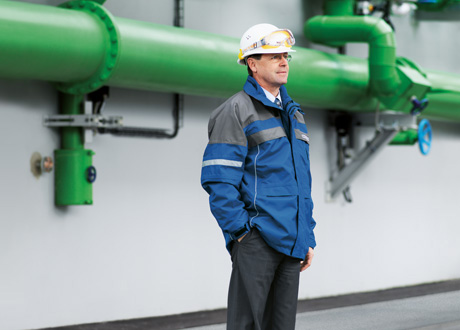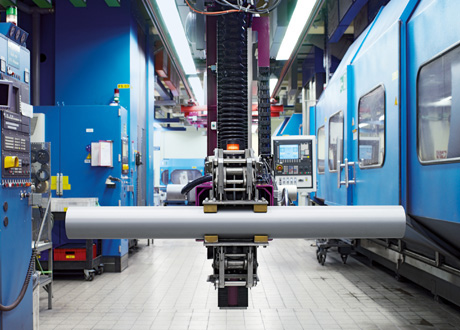How can a global cost and quality leader get even better? |
In the recirculating gas system, by-products and auxiliaries from polysilicon production are processed and fed back into the production process. |
WACKER POLYSILICON repeatedly scrutinizes all of the stages in its processes, thereby improving itself step by step. |
|
Dr. Bortner, you are already operating in the polysilicon market with the lowest costs and the highest quality. Couldn’t you just sit back and take it easy?No, absolutely not. The reason we are so good is that we are constantly improving our processes – from the chemical processes to the deposition of the polysilicon and, finally, the mechanical processing. We try to fine-tune wherever possible without losing sight of the big picture. |
|
What does that mean for your day-to-day work?We continuously increase the yield of our chemical reactions. We do this by experimenting with the chemical starting materials required for the process by changing their quantities and composition. Parallel to that, we optimize individual parameters such as temperatures or throughput, thereby influencing process flows. Apart from that, we benefit from the integrated silicon production system that WACKER has established here in Burghausen. We return by-products to the processes or use them in other production lines. This way, we reduce waste to a minimum. In addition, we optimize energy consumption by re-using the waste heat generated in some processes at other stages of production. |
|
Does economy function in mechanical processing as well?Yes, and this is precisely where all of our employees have to play their part. In our processing plant, which crushes, classifies, and packages the silicon in a fully automated process, chunks of silicon, for example, often fail to make it through the sorting process. However, we can sell these chunks as a high-quality product. One of our employees noticed this. Working together with our engineers, the employee found a solution. At the end of the processing line, we set up a simple device with which we collect sizeable chunks. All in all, this enabled us to produce half a percent more polysilicon. With a current annual capacity of approximately 20,000 metric tons, that makes a huge difference. |
|
How do you find out exactly where you can optimize something?By taking a very close look. In the plant, we gather and analyze an enormous amount of data. This information provides us with indications of further potential improvements. In addition, our key figures and target agreements help us to set ambitious goals and, of course, to achieve them as well. If, on the basis of this information, we get an idea of where exactly we can intervene in our chemical processes, we simulate these processes on a computer. We proceed in a similar way with the mechanical processing of the polysilicon. We analyzed an existing facility and used the findings to optimize a new one. This enabled us to improve cycle times considerably and to increase output by 10%, without losing sight of employee safety, product quality, and process dependability. |
|

|
Dr. Hans-Peter Bortner is head of production at WACKER POLYSILICON in Burghausen. The 52-year-old has been employed by the company for 25 years. He began his career as a developer, and, later, he was the head of various production areas at the WACKER subsidiary Siltronic AG. |
Your mention of process dependability also encompasses plant downtime, which costs a lot of money. How can you reduce these costs?We must ensure maximum quality when the plants and facilities are being built. For example, the individual pipes for hydrogen, chlorosilane, and nitrogen that we need for the polysilicon deposition process have to be clean and dry before they are assembled. After a facility has started up, any impurity would be carried by the process gas into the reactor and, therefore, end up in the downstream product, the silicon rods. We have made enormous progress in all of these areas in recent years, including our cooperation with suppliers and our partner companies. |
|
Can the results be quantified?Of course. Previously, several warm-up runs were necessary to break in new production facilities. Now, we need considerably fewer runs to achieve high product quality. However, after a plant or facility has come into operation, we also have to load and unload it after every process and prepare it for the next production run. In 2009, we managed to reduce this downtime by 10%. This, of course, increases output, especially in periods of high demand. |
|
Speaking of demand, the global market price for polysilicon was over US$ 400 per kilogram just a few years ago. Now, with production capacities having increased enormously, it is less than US$ 100. How do you deal with this?The high price was caused by silicon scarcity. In the meantime, supply and demand have moved more into line with each other. During the peak period, many customers were not selective, as high-quality silicon was not available on the market in sufficient quantities. We have focused on quality throughout our processes, however, and steadily improved our expertise as a result. Now, we are reaping the fruits of our labor. Customers’ requirements are becoming more stringent while we have simultaneously optimized our costs and improved our competitive edge. |
|

|
1 A rod made from hyperpure polycrystalline silicon – rods like this are converted into monocrystals by the float-zone method and then processed into semiconductor wafers. |
|
Since 2007, the number of employees at WACKER POLYSILICON has increased from 1,000 to 1,600, and sales from €450 million to over €1 billion. A further expansion stage is currently being ramped up at the Burghausen plant. At the moment, WACKER POLYSILICON’S share of the global market is around 20%. |